
- •About the Authors
- •Dedication
- •Authors’ Acknowledgments
- •Table of Contents
- •Introduction
- •What’s Not (And What Is) in This Book
- •Mac attack!
- •Who Do We Think You Are?
- •How This Book Is Organized
- •Part I: AutoCAD 101
- •Part II: Let There Be Lines
- •Part III: If Drawings Could Talk
- •Part IV: Advancing with AutoCAD
- •Part V: On a 3D Spree
- •Part VI: The Part of Tens
- •But wait . . . there’s more!
- •Icons Used in This Book
- •A Few Conventions — Just in Case
- •Commanding from the keyboard
- •Tying things up with the Ribbon
- •Where to Go from Here
- •Why AutoCAD?
- •The Importance of Being DWG
- •Seeing the LT
- •Checking System Requirements
- •Suddenly, It’s 2013!
- •AutoCAD Does Windows (And Office)
- •And They’re Off: AutoCAD’s Opening Screens
- •Running with Ribbons
- •Getting with the Program
- •Looking for Mr. Status Bar
- •Let your fingers do the talking: The command window
- •The key(board) to AutoCAD success
- •Keeping tabs on palettes
- •Down the main stretch: The drawing area
- •Fun with F1
- •A Simple Setup
- •Drawing a (Base) Plate
- •Drawing rectangles on the right layers
- •Circling your plate
- •Nuts to you
- •Getting a Closer Look with Zoom and Pan
- •Modifying to Make It Merrier
- •Hip-hip-array!
- •Stretching out
- •Crossing your hatches
- •Following the Plot
- •A Setup Roadmap
- •Choosing your units
- •Weighing up your scales
- •Thinking annotatively
- •Thinking about paper
- •Defending your border
- •A Template for Success
- •Making the Most of Model Space
- •Setting your units
- •Making the drawing area snap-py (and grid-dy)
- •Setting linetype and dimension scales
- •Entering drawing properties
- •Making Templates Your Own
- •Setting Up a Layout in Paper Space
- •Will that be tabs or buttons?
- •View layouts Quick(View)ly
- •Creating a layout
- •Copying and changing layouts
- •Lost in paper space
- •Spaced out
- •A view(port) for drawing in
- •About Paper Space Layouts and Plotting
- •Managing Your Properties
- •Layer one on me!
- •Accumulating properties
- •Creating new layers
- •Manipulating layers
- •Using Named Objects
- •Using AutoCAD DesignCenter
- •Copying layers between drawings
- •Controlling Your Precision
- •Keyboard capers: Coordinate input
- •Understanding AutoCAD’s coordinate systems
- •Grab an object and make it snappy
- •Other Practical Precision Procedures
- •Introducing the AutoCAD Drawing Commands
- •The Straight and Narrow: Lines, Polylines, and Polygons
- •Toeing the line
- •Connecting the lines with polyline
- •Squaring off with rectangles
- •Choosing your sides with polygon
- •(Throwing) Curves
- •Going full circle
- •Arc-y-ology
- •Solar ellipses
- •Splines: The sketchy, sinuous curves
- •Donuts: The circles with a difference
- •Revision clouds on the horizon
- •Scoring Points
- •Commanding and Selecting
- •Command-first editing
- •Selection-first editing
- •Direct object manipulation
- •Choosing an editing style
- •Grab It
- •One-by-one selection
- •Selection boxes left and right
- •Perfecting Selecting
- •AutoCAD Groupies
- •Object Selection: Now You See It . . .
- •Get a Grip
- •About grips
- •A gripping example
- •Move it!
- •Copy, or a kinder, gentler Move
- •A warm-up stretch
- •Your AutoCAD Toolkit
- •The Big Three: Move, Copy, and Stretch
- •Base points and displacements
- •Move
- •Copy
- •Copy between drawings
- •Stretch
- •More Manipulations
- •Mirror
- •Rotate
- •Scale
- •Array
- •Offset
- •Slicing, Dicing, and Splicing
- •Trim and Extend
- •Break
- •Fillet and Chamfer and Blend
- •Join
- •When Editing Goes Bad
- •Zoom and Pan with Glass and Hand
- •The wheel deal
- •Navigating your drawing
- •Controlling your cube
- •Time to zoom
- •A View by Any Other Name . . .
- •Looking Around in Layout Land
- •Degenerating and Regenerating
- •Getting Ready to Write
- •Simply stylish text
- •Taking your text to new heights
- •One line or two?
- •Your text will be justified
- •Using the Same Old Line
- •Turning On Your Annotative Objects
- •Saying More in Multiline Text
- •Making it with Mtext
- •It slices; it dices . . .
- •Doing a number on your Mtext lists
- •Line up in columns — now!
- •Modifying Mtext
- •Gather Round the Tables
- •Tables have style, too
- •Creating and editing tables
- •Take Me to Your Leader
- •Electing a leader
- •Multi options for multileaders
- •How Do You Measure Up?
- •A Field Guide to Dimensions
- •The lazy drafter jumps over to the quick dimension commands
- •Dimension associativity
- •Where, oh where, do my dimensions go?
- •The Latest Styles in Dimensioning
- •Creating and managing dimension styles
- •Let’s get stylish!
- •Adjusting style settings
- •Size Matters
- •Details at other scales
- •Editing Dimensions
- •Editing dimension geometry
- •Editing dimension text
- •Controlling and editing dimension associativity
- •Batten Down the Hatches!
- •Don’t Count Your Hatches. . .
- •Size Matters!
- •We can do this the hard way. . .
- •. . . or we can do this the easy way
- •Annotative versus non-annotative
- •Pushing the Boundary (Of) Hatch
- •Your hatching has no style!
- •Hatch from scratch
- •Editing Hatch Objects
- •You Say Printing, We Say Plotting
- •The Plot Quickens
- •Plotting success in 16 steps
- •Get with the system
- •Configure it out
- •Preview one, two
- •Instead of fit, scale it
- •Plotting the Layout of the Land
- •Plotting Lineweights and Colors
- •Plotting with style
- •Plotting through thick and thin
- •Plotting in color
- •It’s a (Page) Setup!
- •Continuing the Plot Dialog
- •The Plot Sickens
- •Rocking with Blocks
- •Creating Block Definitions
- •Inserting Blocks
- •Attributes: Fill-in-the-Blank Blocks
- •Creating attribute definitions
- •Defining blocks that contain attribute definitions
- •Inserting blocks that contain attribute definitions
- •Edit attribute values
- •Extracting data
- •Exploding Blocks
- •Purging Unused Block Definitions
- •Arraying Associatively
- •Comparing the old and new ARRAY commands
- •Hip, hip, array!
- •Associatively editing
- •Going External
- •Becoming attached to your xrefs
- •Layer-palooza
- •Creating and editing an external reference file
- •Forging an xref path
- •Managing xrefs
- •Blocks, Xrefs, and Drawing Organization
- •Mastering the Raster
- •Attaching a raster image
- •Maintaining your image
- •Theme and Variations: Dynamic Blocks
- •Lights! Parameters!! Actions!!!
- •Manipulating dynamic blocks
- •Maintaining Design Intent
- •Defining terms
- •Forget about drawing with precision!
- •Constrain yourself
- •Understanding Geometric Constraints
- •Applying a little more constraint
- •AutoConstrain yourself!
- •Understanding Dimensional Constraints
- •Practice a little constraint
- •Making your drawing even smarter
- •Using the Parameters Manager
- •Dimensions or constraints — have it both ways!
- •The Internet and AutoCAD: An Overview
- •You send me
- •Send it with eTransmit
- •Rapid eTransmit
- •Bad reception?
- •Help from the Reference Manager
- •Design Web Format — Not Just for the Web
- •All about DWF and DWFx
- •Autodesk Design Review 2013
- •The Drawing Protection Racket
- •Autodesk Weather Forecast: Increasing Cloud
- •Working Solidly in the Cloud
- •Free AutoCAD!
- •Going once, going twice, going 123D
- •Your head planted firmly in the cloud
- •The pros
- •The cons
- •Cloudy with a shower of DWGs
- •AutoCAD 2013 cloud connectivity
- •Tomorrow’s Forecast
- •Understanding 3D Digital Models
- •Tools of the Trade
- •Warp speed ahead
- •Entering the third dimension
- •Untying the Ribbon and opening some palettes
- •Modeling from Above
- •Using 3D coordinate input
- •Using point filters
- •Object snaps and object snap tracking
- •Changing Planes
- •Displaying the UCS icon
- •Adjusting the UCS
- •Navigating the 3D Waters
- •Orbit à go-go
- •Taking a spin around the cube
- •Grabbing the SteeringWheels
- •Visualizing 3D Objects
- •Getting Your 3D Bearings
- •Creating a better 3D template
- •Seeing the world from new viewpoints
- •From Drawing to Modeling in 3D
- •Drawing basic 3D objects
- •Gaining a solid foundation
- •Drawing solid primitives
- •Adding the Third Dimension to 2D Objects
- •Creating 3D objects from 2D drawings
- •Modifying 3D Objects
- •Selecting subobjects
- •Working with gizmos
- •More 3D variants of 2D commands
- •Editing solids
- •Get the 2D Out of Here!
- •A different point of view
- •But wait! There’s more!
- •But wait! There’s less!
- •Do You See What I See?
- •Visualizing the Digital World
- •Adding Lighting
- •Default lighting
- •User-defined lights
- •Sunlight
- •Creating and Applying Materials
- •Defining a Background
- •Rendering a 3D Model
- •Autodesk Feedback Community
- •Autodesk Discussion Groups
- •Autodesk’s Own Bloggers
- •Autodesk University
- •The Autodesk Channel on YouTube
- •The World Wide (CAD) Web
- •Your Local ATC
- •Your Local User Group
- •AUGI
- •Books
- •Price
- •3D Abilities
- •Customization Options
- •Network Licensing
- •Express Tools
- •Parametrics
- •Standards Checking
- •Data Extraction
- •MLINE versus DLINE
- •Profiles
- •Reference Manager
- •And The Good News Is . . .
- •APERTURE
- •DIMASSOC
- •MENUBAR
- •MIRRTEXT
- •OSNAPZ
- •PICKBOX
- •REMEMBERFOLDERS
- •ROLLOVERTIPS
- •TOOLTIPS
- •VISRETAIN
- •And the Bonus Round
- •Index
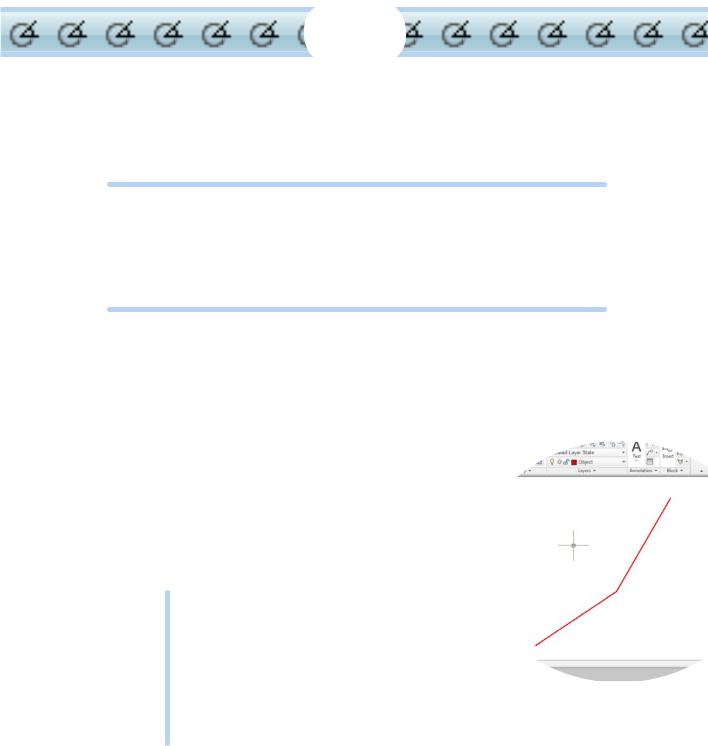
7
Preciseliness Is Next to CADliness
In This Chapter
Typing coordinates at the keyboard
Getting to know AutoCAD’s Coordinate Systems
Snapping to object features
Using other precision drawing and editing techniques
Drawing precision is vital to good CAD drafting practice, even more than for manual drafting. (Accuracy, of course, is vital to both types of
drafting — if you’re sketchy on the difference between accuracy and precision, look ahead to the “CAD precision versus accuracy” sidebar in this chapter.) If you think CAD managers get a little tense when you assign properties directly to objects instead of ByLayer, wait until you see them lay into someone (we sincerely hope it’s not you!) who doesn’t use preci-
sion techniques when creating drawings in AutoCAD.
Controlling Your Precision
In AutoCAD, lack of precision makes later editing, hatching, and dimensioning tasks much more difficult and time consuming. Keep these facts in mind:
Small errors in precision in the early stages of creating or editing a drawing often have a big effect on productivity and precision later.
CAD drawings are often used for much more than just giving a picture to someone. If they’ve been
properly created, they can also be queried for things like sizes, areas, and quantities.
Drawings may guide manufacturing and construction projects; drawing data may drive automatic manufacturing machinery. Huge amounts of money and even lives can ride on a drawing’s precision.
www.it-ebooks.info
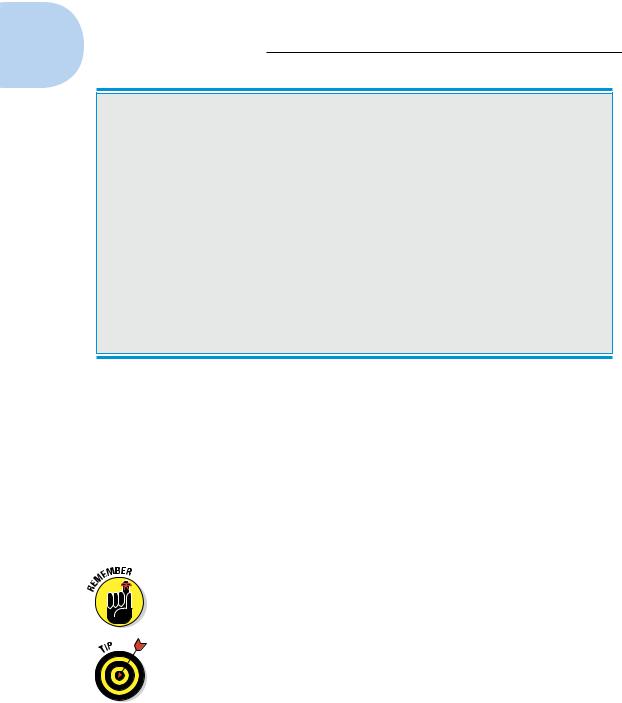
148 Part II: Let There Be Lines
CAD precision versus accuracy
You often hear the words precision and accuracy used interchangeably, but it’s useful to understand the difference. In this book, we use precision to mean controlling the placement of objects so they lie exactly where you want them to lie in the drawing. For example, lines whose endpoints meet must meet exactly, and a circle that’s supposed to be centered on the coordinates 0,0 must be drawn with its center exactly at 0,0. We use accuracy to refer to the degree to which your drawing matches its real-world counterpart. An accurate floor plan is one in which the dimensions of the CAD objects equal the dimensions of the as-built house. In a sense,
then, it’s not the drawing that should be accurate — it’s the house!
CAD precision usually helps produce accurate drawings, but that’s not always the case. You can produce a precise CAD drawing that’s inaccurate because you started from inaccurate information (for example, the contractor gave you a wrong field measurement). Or you might deliberately exaggerate certain distances to convey the relationship between objects more clearly on the plotted drawing. Even where you must sacrifice accuracy, aim for precision.
In recognition of these facts, a passion for precision permeates the profession. Precision is one of the characteristics that separates CAD from ordinary illustration-type drawing work. The sooner you get fussy about precision in AutoCAD, the happier everyone is.
When we talk about drawing things precisely, we mean using precision techniques and tools to specify points and distances with as much exactness as the program allows. Luckily, AutoCAD provides a comprehensive package of tools for doing just that. Table 7-1 lists the more important AutoCAD precision techniques, along with visual cues to the status bar buttons that you click to toggle some of the features.
As we describe in Chapter 2, you can switch the display on status bar buttons between text and icons by right-clicking any of those buttons and selecting or deselecting Use Icons. Table 7-1 shows the icons and lists the text for both alternatives.
Precision is especially important when you’re drawing or editing geometry — the lines, arcs, and so on that make up whatever you’re representing in the CAD drawing. Precision placement usually is less important with notes, leaders, and other annotations that describe, not show.
www.it-ebooks.info
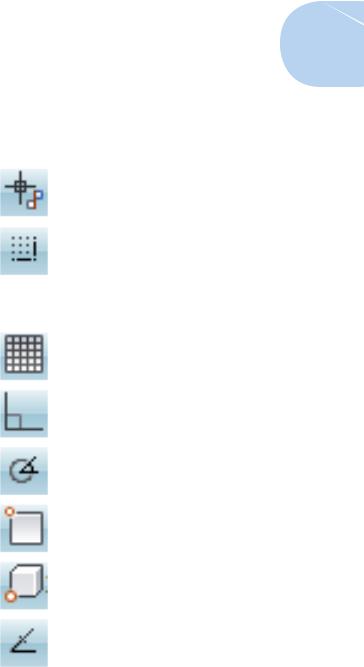
|
|
|
Chapter 7: Preciseliness Is Next to CADliness 149 |
|||
|
|
|
||||
|
|
|
|
|
||
|
Table 7-1 |
|
|
Precision Tools and Techniques |
|
|
|
Technique |
Status Bar |
Status Bar |
Description |
||
|
|
Button |
Button |
|
|
|
|
|
Label |
Icon |
|
|
|
|
Infer |
INFER |
|
Applies geometric constraints at |
|
|
|
Constraints |
|
|
|
specific pick points (not in AutoCAD |
|
|
|
|
|
|
LT); see Chapter 19. |
|
|
|
|
|
|
|
|
|
Snap mode |
SNAP |
|
Forces the crosshairs to move on |
||
|
|
|
|
|
an imaginary grid of equally spaced |
|
|
|
|
|
|
hot spots. |
|
|
|
|
|
|
|
|
|
Polar snap |
— |
— |
Forces the crosshairs to move spe- |
||
|
|
|
|
|
cific distances along polar tracking |
|
|
|
|
|
|
angles. |
|
|
Grid display |
GRID |
|
Displays a nonprinting reference |
|
|
|
|
|
|
|
grid of lines or dots arranged in |
|
|
|
|
|
|
rows or columns. |
|
|
|
|
|
|
|
|
|
Ortho mode |
ORTHO |
|
Forces the crosshairs to move |
||
|
|
|
|
|
horizontally or vertically from the |
|
|
|
|
|
|
previous point. |
|
|
|
|
|
|
|
|
|
Polar tracking |
POLAR |
|
Causes the crosshairs to jump to |
||
|
|
|
|
|
specified angles. |
|
|
|
|
|
|
|
|
|
Object snap |
OSNAP |
|
Enables picking specific points on |
||
|
|
|
|
|
existing drawing objects multiple |
|
|
|
|
|
|
times. |
|
|
|
|
|
|
|
|
|
3D Object |
3DOSNAP |
|
Enables picking specific points on |
||
|
snap |
|
|
|
existing 3D objects multiple times |
|
|
|
|
|
|
(not in AutoCAD LT). |
|
|
|
|
|
|
|
|
|
Object snap |
OTRACK |
|
Causes the crosshairs to locate |
||
|
tracking |
|
|
|
new points based on multiple |
|
|
|
|
|
|
object snap points. |
|
|
|
|
|
|
|
|
|
Object snap |
— |
— |
Enables picking specific points on |
||
|
overrides |
|
|
|
existing drawing objects one time |
|
|
|
|
|
|
only. |
|
|
Coordinate |
— |
— |
Enables you to type exact X,Y or |
|
|
|
input |
|
|
|
polar coordinates. |
|
|
Direct distance |
— |
— |
Enables you to locate a point by |
|
|
|
entry |
|
|
|
typing a distance and moving the |
|
|
|
|
|
|
crosshairs to show the direction. |
|
www.it-ebooks.info
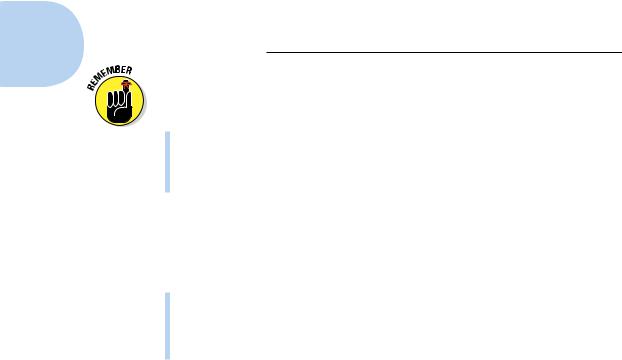
150 Part II: Let There Be Lines
Before you draw objects, always check the status bar buttons and set them according to your precision needs.
A button that looks lit (that is, just a little brighter than its neighbors — typically, a light blue) indicates that the feature is on.
A button that looks dimmed (typically, dark gray) indicates that the feature is off.
Keyboard capers: Coordinate input
The most direct way to enter points precisely is to type numbers at the keyboard. AutoCAD uses these keyboard coordinate entry formats:
Absolute Cartesian (X,Y) coordinates in the form X,Y (for example, 7,4)
Relative X,Y coordinates in the form @X,Y (for example, @3,2)
Relative polar coordinates in the form @distance<angle (for example,
@6<45)
Understanding AutoCAD’s coordinate systems
AutoCAD stores locational data for every object in a drawing based on a centuries-old system of Cartesian, or X,Y, coordinates.
Cartesian coordinates are named for French philosopher René “I think, therefore I am” Descartes. In his Discourse on Method, Descartes came up with the idea of locating any point on a planar surface by measuring its distance from the intersection of a pair of axes (that’s axes as in more than one axis, not the tool for chopping wood). By convention, the intersection of those axes (called, also by convention, the X-axis and the Y-axis) are perpendicular to one another, and their intersection point is identified as 0,0. The logical next step in this system of X,Y coordinates is to introduce a third axis (called, what else, the Z-axis), perpendicular to the plane defined by the X- and Y-axes. This one shares the X,Y intersection point of 0,0 and so its coordinates are identified as 0,0,0.
Theoretically, any point in three-dimensional space can be located by a set of X,Y,Z coordinates. And by extension, every point in an AutoCAD drawing file can be identified by its X,Y,Z coordinates (in most 2D drawings, the Z-coordinate is 0). This system of coordinates is referred to in AutoCAD as the World Coordinate System, or WCS.
Introducing User Coordinate Systems
Many times, it’s convenient to define additional coordinate systems to make drawing things a little easier, so AutoCAD lets you roll your own. These non– World Coordinate Systems are called User Coordinate Systems (UCS for short),
www.it-ebooks.info
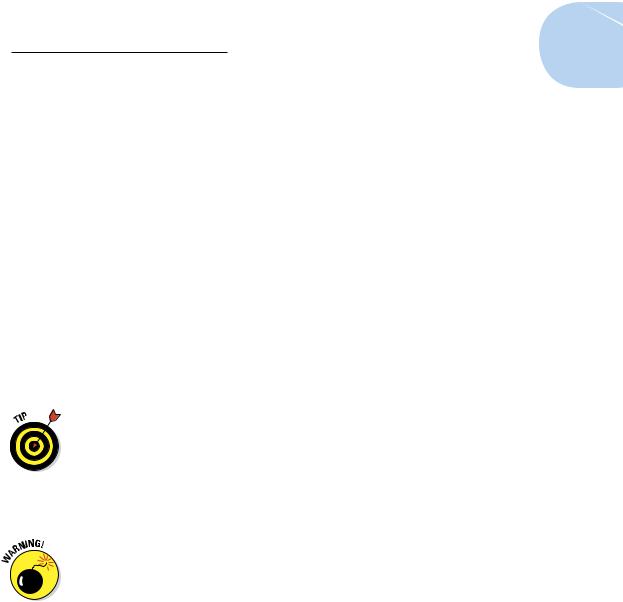
Chapter 7: Preciseliness Is Next to CADliness 151
and they’re so widely used that UCS now refers to every coordinate system in AutoCAD.
Why would you want to diverge from the standard WCS? Well, the most common reason is that you might be working in 3D, and it’s way easier to calculate and enter coordinates if they’re based on the plane you want to work on. For example, say you’re modeling one of those old-fashioned wedgeshaped rubber doorstops, and you want to add the manufacturer’s logo to the sloping surface of the wedge. That’s not easy if you stay in the WCS, but AutoCAD lets you set a new UCS based on that sloping surface. After that UCS is made current, you draw in it just as you draw in the WCS. (We have more to say about UCSs in 3D in Chapter 21.)
Think of the real world. A specific latitude and longitude (WCS) always identifies the same point, but the actual location for a description like “the corner of 33rd and Main” depends on which city you’re in (UCS).
UCSs can be useful on two dimensions as well as three. The WCS assumes the north direction is straight up — 90 degrees, according to AutoCAD’s defaults — but your drawing might work better on a sheet where north pointed to the left. Easy enough — create a UCS with north pointing left (we’ll leave you to look up this process in the online help — we only have so many pages!)
It’s generally easier to create a UCS by typing options at the command line, but after they’re created, they’re easier to manage through the UCS dialog box. Type UCSMAN and press Enter to display this dialog box.
AutoCAD’s UCS icon shows you clearly whether you’re in paper space or model space, and almost as clearly whether you’re in the WCS or a UCS if you’re in model space. Figure 7-1 shows AutoCAD 2013’s variations on the theme.
You can use the UCS command in paper space as well as model space, but it’s almost always a bad idea. Leave paper space in the WCS to make your plotting a whole lot easier.
The UCS icon is selectable; click it, and grips appear at the origin and the ends of the axis indicators. You can drag the icon by its grips to set a new UCS. We cover this feature more fully in Chapter 21.
Drawing by numbers
AutoCAD locates absolute X,Y coordinates with respect to the 0,0 point (otherwise known as the origin) of the drawing — usually its lower-left corner. AutoCAD locates relative X,Y coordinates and relative polar coordinates with respect to the previous point that you picked or typed. Figure 7-2 demonstrates how to use all three coordinate formats to draw a pair of line seg-
ments that start at absolute coordinates 2,1; then go 3 units to the right and 2 units up relative to the first point; then relative to that point, go 4 units at an angle of 60 degrees.
www.it-ebooks.info
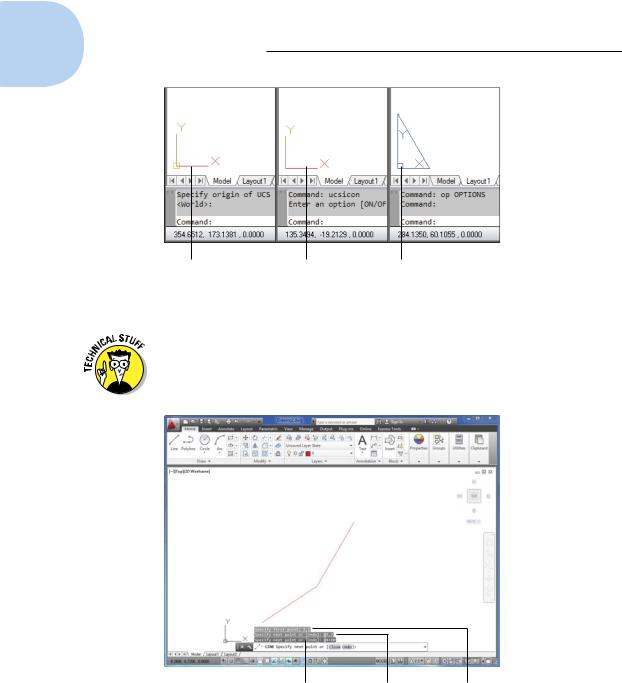
152 Part II: Let There Be Lines
Icon indicates |
Icon indicates User |
Icon indicates |
World Coordinate |
Coordinate System. |
paper space. |
System. |
|
|
Figure 7-1: The UCS icon shows you your current coordinate system.
In case you’re wondering, AutoCAD also understands absolute polar coordinates in the form distance<angle, but this format is almost never useful.
Relative polar |
Relative X, Y |
Absolute X, Y |
coordinates |
coordinates |
coordinates |
Figure 7-2: Coordinating from the keyboard.
www.it-ebooks.info
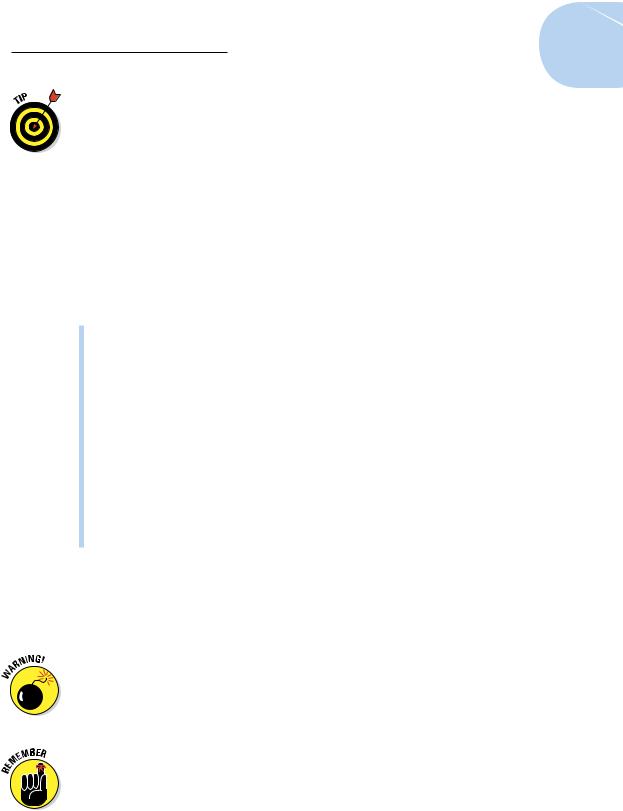
Chapter 7: Preciseliness Is Next to CADliness 153
You can find out the X,Y location of your crosshairs by moving them around in the drawing area and reading the coordinate values at the left end of the status bar. The X,Y coordinates should change as you move the crosshairs. If the coordinates don’t change, click the drawing coordinates area until you see <Coords on> in the command window.
Astute observers of the full version of AutoCAD will have noticed that there are three numbers at the left end of the status bar (AutoCAD LT is numerically challenged). AutoCAD is actually showing you the X,Y coordinates of the crosshairs and the current elevation (the Z value). However, in 2D drafting, the Z value is (or should be) 0, so you can continue calling them X,Y coordinates.
Although it’s not apparent at first, there are, in fact, four coordinate display modes. Clicking the coordinates readout cycles through them, as follows:
Off (<Coords off>): The status bar coordinate readout is dimmed, and the coordinate values don’t update until you pick a point.
On, showing X,Y coordinates (<Coords on>): The coordinate readout appears black, and the absolute X,Y coordinates update continuously as you move the crosshairs. If no command is active, clicking the coordinates readout alternates between this mode and <Coords off>.
On, showing polar coordinates (<Coords on>): This mode, which displays distance and angle relative to the last point picked rather than absolute X,Y values, appears if a command is active and AutoCAD is waiting for you to pick a point.
On, showing geographic coordinates (<Coords on>): This mode displays coordinates as the latitude and longitude values, but can be used only after you set the drawing’s geographic location with the, what else, GeographicLocation command.
If you start a command such as LINE, pick a point, and then click the Coordinates area a few times, the display changes from coordinates off to live absolute coordinates (X,Y position) to live polar coordinates (distance and angle from the previous point). Displaying live polar coordinates is the most informative mode most of the time.
When you type coordinates at the command line, do not add any spaces because AutoCAD interprets a space as though you’ve pressed Enter. This “Spacebar = Enter” weirdness is a productivity feature that’s been in AutoCAD forever. It’s easier to find the spacebar than the Enter key when
you’re entering lots of commands and coordinates in a hurry — and it’s especially handy for touch typists who are all thumbs.
If you’re working in AutoCAD’s Architectural or Engineering units, the default unit of entry is inches, not feet. Here are some things to consider about entering numeric values when you work in feet and inches:
www.it-ebooks.info
